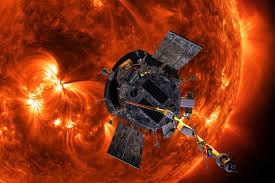
A Nasa spacecraft is trying to make history by making the closest approach to the Sun ever recorded.The Parker Solar Probe is plunging into our star’s outer atmosphere, enduring brutal temperatures and extreme radiation.
It has been out of communication for several days during this burning hot fly-by, and scientists will be waiting for a signal, expected at 05:00 GMT on 28 December, to see if it has survived. The hope is that it might help us better understand the Sun’s mechanism and work.
Dr Nicola Fox, head of science at NASA, has told BBC News: “For centuries, people have studied the Sun, but you don’t experience the atmosphere of a place until you visit it. And so we can’t really experience our star’s atmosphere unless we fly through it.”
The Parker Solar Probe was launched in 2018, moving to the heart of our solar system. It has passed over the Sun 21 times and will get closer yet, but it has not visited since Christmas Eve. At its closest, the probe is 3.8 million miles (6.2 million kilometres) from our star’s surface.
This might not seem all that close, but NASA’s Nicola Fox points out: “We are 93 million miles away from the Sun, so if I put the Sun and the Earth one metre apart, Parker Solar Probe is four centimetres from the Sun – so that’s close.”
The probe must also withstand temperatures of 1,400C and radiation that could frazzle the onboard electronics. It’s protected by an 11.5cm (4.5 inches) thick carbon-composite shield, but the spacecraft’s tactic is to go in and out quickly.
In fact, it will travel faster than anything made by humans, accelerating at 430,000mph—that’s flying from London to New York in under 30 seconds. Parker’s velocity results from the tremendous gravitational force it experiences falling toward the Sun.



